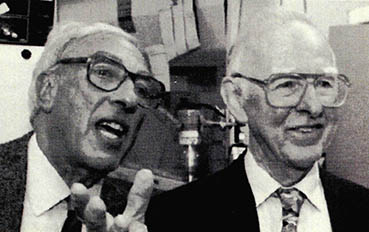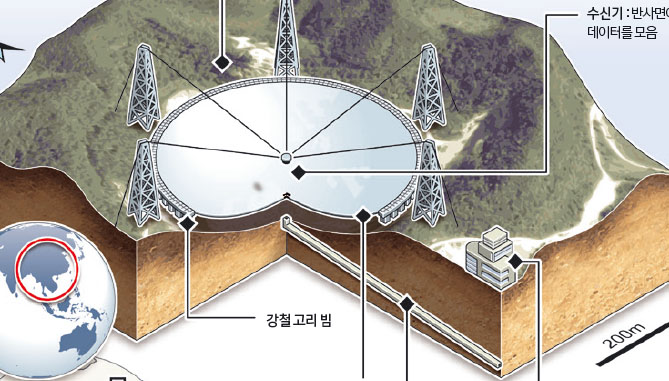가솔린 바다를 찾는다고 상상해 보자! 실제로 그런것이 있을 수도 있다. 어느 두곳에 그것이 있을지 모른다. 그러나 물론 지상에 있는것은 아니다.
태양계에는 7개의 큰 위성이 있는데, 달은 그중의 하나이다. 달은 아주 작은 데다가 (직경 2, 16마일) 중력이 너무 약해서 대기층을 가질 수 없다. 이것은, 온도가 올라갈수록 대기를 가질 수 있는 가능성이 적어진다는 사실 때문에 더욱 그러하다. 달은 큰 위성들중에서 태양에 가장 가까울 뿐더러 때때로 그 온도가 물의 비등점 이상으로 올라간다.
목성은 4개의 큰 위성을 갖고 있는데, 그것들은 달이 받는 태양열의 약 1/27만을 받고 있을 뿐이다. 더우기 그들 중 2개인 '가니미드'와 '칼리스토'는 특히 커서 직경이 3천마일 이상이다. 그러나 그것들도 대기층을 갖기에는 너무 작고, 너무 따뜻하다.
토성은 '타이탄'이라는 한 개의 큰 위성을 갖고 있다. 그것은 직경이 3천마일 이상이고 달의 1/90에 해당하는 태양열을 받는다. 타이탄은 대기층을 가질 수 있을만큼 크고 또 차다. 1948년에 '쿠이퍼'는 이 대기층을 조사하였고, 그 속에 탄소와 수소의 합성물인 메탄이 함유되어 있음을 발견하였다. 메탄은 지구에서 우리가 '천연 가스'라고 부르는 것의 주요 성분이다.
그러나 1981년에 탐사용 로킷 보이저2호가 토성을 지나갔을 때, 타이탄이 의외로 아주 두꺼운 대기층을 갖고 있다는 사실이 밝혀졌는데, 그것은 지구의 대기층보다 훨씬 두꺼운 것이었다. 메탄이 있었고 게다가 많은양의 질소가 함유되어 있었다.(차가운 질소는 원거리에서의 발견이 거의 불가능하다.)
타이탄의 대기층은 타이탄 표면을 볼 수 없을 정도로 짙다. 그러나 천문학자들은 질소와 메탄의 행태에는 익숙하고, 따라서 무엇이 일어날 지 짐작할 수 있다. 불활성 가스인 질소는 변화하지 않는다. 그러나 메탄은 태양에너지에 의해 분리되는 분자를 가지고 있고, 그 분리 인자는 탄소와 수소로 구성되는 보다 큰 분자를 형성할 수 있다. 메탄은 그 분자중 한개의 탄소 원자를 가지고 있지만, 태양방사선은 2개, 3개 혹은 그 이상의 탄소 원자를 가진 분자로 그것을 결합시킨다.
질소와 메탄은 타이탄의 온도에서는 가스이지만, 보다 복잡한 분자구조가 되면 액체가 된다. 그러므로 타이탄의 두꺼운 대기층밑에는 2개의 탄소원자(에탄이라 불리는) 혹은 3개의 탄소원자(프로판이라고 불리는), 혹은 그 이상의 탄소로 구성되는 분자의 웅덩이나 호수 강, 바다까지 있을 수 있다. 7개나 8개의 원자를 가진 분자들은 가솔린이 된다. 그것들은 타이탄의 기온에서는 응고될 수 있지만 그 응고체는 에탄 프로판 바다에서는 용해될 것이다.
그러므로 타이탄의 두꺼운 대기층 아래에는 가솔린 바다가 있을것이라는 결론에 이르게 된다.
타이탄외에도 또 다른 큰 위성이 하나 있다. 트리톤이라고 하는, 가장 멀리 있는 행성인 해왕성의 위성이 그것이다. 지금 보이저2호가 토성넘어에 있고 큰 위성을 가지 않은 천왕성을 지나 해왕성을 향해 가고 있다. 2년이상 지나면 해왕성에 닿을 것이다. 트리톤에서 무엇을 발견할 것인가?
트리톤은 크기가 거의 타이탄만 하고 기온은 더욱 차다. 그것은 달의 1/900, 타이탄의 1/10에 해당하는 태양열을 받을 뿐이기 때문이다. 그러므로 트리톤 역시 대기층을 갖고 있고 타이탄과 같이 메탄과 질소를 갖고 있다.
트리톤은 아주 차서 질소와 메탄이 액체상태일 것이고, 그러므로 메탄 액체가 표면에 뜨는 '질소바다'를 갖고 있음에 틀림없다.
메탄이 보다 큰 분자로 될 수 있겠는가? 멀리 떨어져 있는 태양 복사는 그것을 하기에는 너무 약하다. 그러나 트리톤은 대체로 우주와 같이 우주선(宇宙線)을 쏘이고 있고 수십억년에 걸쳐 분자들을 구성해 왔음에 틀림없다. 그러므로 트리톤에도 역시 가솔린 바다가 있을 것이다.
그러나 있다해도 두 바다는 이용하기가 그리 적당하지 않다. 타이탄은 지구에서 8억8천6백만 마일 떨어져 있고, 트리톤은 그것의 세배인 28억마일 떨어져 있다. 이런 거리라면 우리가 가지고 올 수 있는 가솔린은 틀림없이 비싸게 먹힐 것이다. 그밖에 멀리 있는 가솔린을 가져와서 지구에서 태운다는 것은 그리 좋은 생각이 못된다. 그것은 지구의 산소를 고갈시키고 이산화탄소로 대치시킬 것이다. 이 문제는 이미 지구의 가솔린과 석탄을 연소시킴으로써 야기되었던 문제이다.
그러나 언젠가는 인간이 다른 태양계의 위성에 대규모 정착을 하는 그런날이 올지도 모른다. 그 경우에 타이탄과 트리톤은 좋은 자원이 될 수 있을 것이다.
확실히 그들이 공급하게 될 가솔린은 에너지용이지는 않을 것이다. 왜냐하면 원거리 이주에 의한 정착생활은 핵발전에 의해 영위될 것이기 때문이다.
그러나 그렇게 멀리 떨어진 바다는 질소와 탄소 수소로 이루어져 있고, 이 세 요소는 정주유지에 필수적인 것이다. 그리고 이것은 우리가 접근할 수 있는 대부분의 세계에서는 상대적으로 희박한 것들이다. (예를 들어 달은 이 세가지중 아무것도 갖고 있지 않다. 달의 이주민들은 지구로부터의 공급에 의존해야 할것이다.) 다행히도 멀리 떨어져 있는 전초기지는 타이탄이나 트리톤에서 그들이 필요로 하는 것을 얻을 수 있을 것이다.
Imagine finding an ocean of gasoline! Actually, there may be such a thing. In fact, it may exist in two different places. But not on Earth , of course.
There are seven large satellites in our solar system, and our moon is one of them. It is too small (2,160 miles across), with too weak a gravitational pull, to hold an atmosphere. This especially true since ability to hold an atmosphere lessens as temperature goes up. The moon is the nearest of the large satellites to the sun and its temperature is sometimes above the boiling point of water.
Jupiter has four large satellites, which get only 1/27 as much heart from the sun as our moon does. What's more, two of them, Ganymede and Callisto, are particularly large - more than 3,000 miles across. Still, they are too small and too warm to have atmospheres.
Saturn has one large satellite, Titan, which is also more than 3,000 miles across and gets only 1/90 the heart from the sun that the moon does. It is large enough and cold enough to have an atmosphere.
Back in 1948, G. P. Kuiper detected this atmosphere and found it to contain methane, a compound of carbon and hydrogen. Methane is the chief component of what, on Earth, we call "natural gas."
But in 1981, when the probe Voyager 2 passed Saturn, it showed that Titan had an unexpectedly thick atmosphere, one that might be even thicker than Earth's. The methane was there, and, in addition, a large quantity of nitrogen. (Cold nitrogen is almost impossible to detect at a great distance.)
Titan's atmosphere is hazy so that we can't see through it to the surface. However, astronomers are familiar with the behavior of nitrogen and methane and can guess what might happen. Nitrogen, an inert gas, would not change. Methane, however, can have its molecule pulled apart by the energy of sunshine and the parts could come together into larger molecules made up of carbon and hydrogen. Methane has only one carbon atom in its molecule, but the radiation from the sun might combine it into molecules with two carbon atoms, or three or more.
Nitrogen and methane are gases at Titan's temperature, but the more complicated molecules would be liquids. It is possible, then, that under Titan's thick atmosphere, there may be puddles, lakes, rivers, even oceans, of molecules with two carbon atoms (called "ethane"), or three ("propane")
or more. Molecules with seven or eight carbon atoms would be gasoline. They might be solid at Titan's temperatures, but such solids would dissolve in the ethane/propane ocean.
What is amounts to, then, is that Titan, under the haze of its atmosphere, may possess a gasoline ocean.
If we look beyond Titan, one large satellite remains. Named Triton, it circles Neptune, the most distant of the large planets. Right now, Voyager 2, having passed Uranus, the planet that lies beyond Saturn, and which has no large satellites, is speeding toward Neptune and will reach it in two more years. What will it discover about Triton?
Triton is almost as large as Titan and even colder, since it gets only 1/900 the heart from the sun that our moon does and only 1/10 the heat that Titan gets. Triton should, therefore, have an atmosphere also, and quite likely on that is like Titan's - methane and nitrogen.
Triton is so cold that even nitrogen and methane would be liquids, so that is ought to have a nitrogen ocean, with liquid methane floating on its surface.
Could the methane be built up into larger molecules? The radiation from the distant sun might be too weak to do the job, but Triton, like the universe in general, is bombarded with cosmic rays, and over billions of years they should have built up the molecules. There may, therefore, be a gasoline ocean on Triton, too.
However, those two oceans, if they exist, are not just ripe for the taking. Titan is about 886,000,000 miles from us, and Triton is three times farther still, 2,800,000,000 miles away. At such distances, any gasoline we can retrieve would be expensive indeed. Besides, it wouldn't be a good idea to bring back this distant gasoline and burn it here. It would just use up our oxygen and replace it with carbon dioxide, trouble already caused from burning our own gasoline and coal.
However, the time may someday come when human beings have large settlements in the outer solar system. In that case, Titan and Triton may prove to be valuable resources.
To be sure, the gasoline they will supply will undoubtedly not be needed for energy purposes because the distant settlements should, presumably, be running on nuclear fusion reactors.
However, those distant oceans are made up of nitrogen, carbon and hydrogen, three elements that are essential to maintain the settlements and that are relatively rare on most of the worlds we can approach. (The moon has none of these elements, for instance, so lunar colonists will depend on Earth for their supply.) The distant outposts might therefore be thankful to get what they need from Titan and Triton.
(c) 1987, Los Angeles Times Syndicate

















